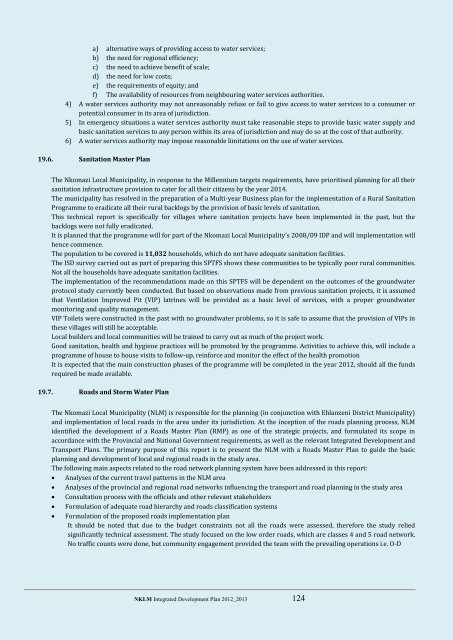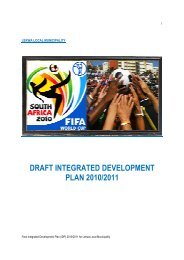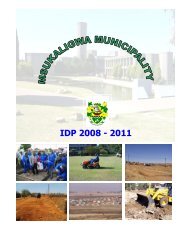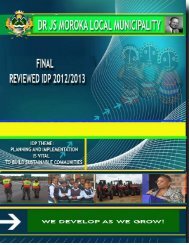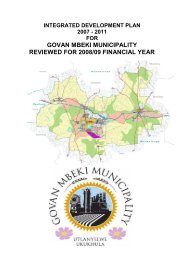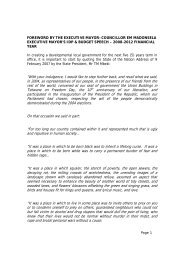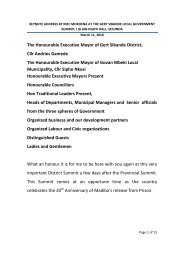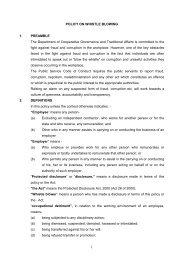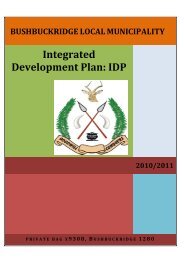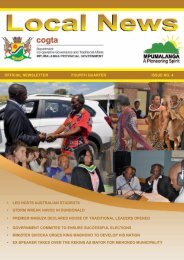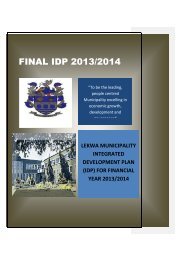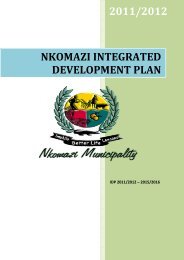Nkomazi Local Municipality 20 - Co-operative Governance and ...
Nkomazi Local Municipality 20 - Co-operative Governance and ...
Nkomazi Local Municipality 20 - Co-operative Governance and ...
- No tags were found...
You also want an ePaper? Increase the reach of your titles
YUMPU automatically turns print PDFs into web optimized ePapers that Google loves.
a) alternative ways of providing access to water services;b) the need for regional efficiency;c) the need to achieve benefit of scale;d) the need for low costs;e) the requirements of equity; <strong>and</strong>f) The availability of resources from neighbouring water services authorities.4) A water services authority may not unreasonably refuse or fail to give access to water services to a consumer orpotential consumer in its area of jurisdiction.5) In emergency situations a water services authority must take reasonable steps to provide basic water supply <strong>and</strong>basic sanitation services to any person within its area of jurisdiction <strong>and</strong> may do so at the cost of that authority.6) A water services authority may impose reasonable limitations on the use of water services.19.6. Sanitation Master PlanThe <strong>Nkomazi</strong> <strong>Local</strong> <strong>Municipality</strong>, in response to the Millennium targets requirements, have prioritised planning for all theirsanitation infrastructure provision to cater for all their citizens by the year <strong>20</strong>14.The municipality has resolved in the preparation of a Multi-year Business plan for the implementation of a Rural SanitationProgramme to eradicate all their rural backlogs by the provision of basic levels of sanitation.This technical report is specifically for villages where sanitation projects have been implemented in the past, but thebacklogs were not fully eradicated.It is planned that the programme will for part of the <strong>Nkomazi</strong> <strong>Local</strong> <strong>Municipality</strong>’s <strong>20</strong>08/09 IDP <strong>and</strong> will implementation willhence commence.The population to be covered is 11,032 households, which do not have adequate sanitation facilities.The ISD survey carried out as part of preparing this SPTFS shows these communities to be typically poor rural communities.Not all the households have adequate sanitation facilities.The implementation of the recommendations made on this SPTFS will be dependent on the outcomes of the groundwaterprotocol study currently been conducted. But based on observations made from previous sanitation projects, it is assumedthat Ventilation Improved Pit (VIP) latrines will be provided as a basic level of services, with a proper groundwatermonitoring <strong>and</strong> quality management.VIP Toilets were constructed in the past with no groundwater problems, so it is safe to assume that the provision of VIPs inthese villages will still be acceptable.<strong>Local</strong> builders <strong>and</strong> local communities will be trained to carry out as much of the project work.Good sanitation, health <strong>and</strong> hygiene practices will be promoted by the programme. Activities to achieve this, will include aprogramme of house to house visits to follow-up, reinforce <strong>and</strong> monitor the effect of the health promotionIt is expected that the main construction phases of the programme will be completed in the year <strong>20</strong>12, should all the fundsrequired be made available.19.7. Roads <strong>and</strong> Storm Water PlanThe <strong>Nkomazi</strong> <strong>Local</strong> <strong>Municipality</strong> (NLM) is responsible for the planning (in conjunction with Ehlanzeni District <strong>Municipality</strong>)<strong>and</strong> implementation of local roads in the area under its jurisdiction. At the inception of the roads planning process, NLMidentified the development of a Roads Master Plan (RMP) as one of the strategic projects, <strong>and</strong> formulated its scope inaccordance with the Provincial <strong>and</strong> National Government requirements, as well as the relevant Integrated Development <strong>and</strong>Transport Plans. The primary purpose of this report is to present the NLM with a Roads Master Plan to guide the basicplanning <strong>and</strong> development of local <strong>and</strong> regional roads in the study area.The following main aspects related to the road network planning system have been addressed in this report: Analyses of the current travel patterns in the NLM area Analyses of the provincial <strong>and</strong> regional road networks influencing the transport <strong>and</strong> road planning in the study area <strong>Co</strong>nsultation process with the officials <strong>and</strong> other relevant stakeholders Formulation of adequate road hierarchy <strong>and</strong> roads classification systems Formulation of the proposed roads implementation planIt should be noted that due to the budget constraints not all the roads were assessed, therefore the study reliedsignificantly technical assessment. The study focused on the low order roads, which are classes 4 <strong>and</strong> 5 road network.No traffic counts were done, but community engagement provided the team with the prevailing operations i.e. O-DNKLM Integrated Development Plan <strong>20</strong>12_<strong>20</strong>13 124


